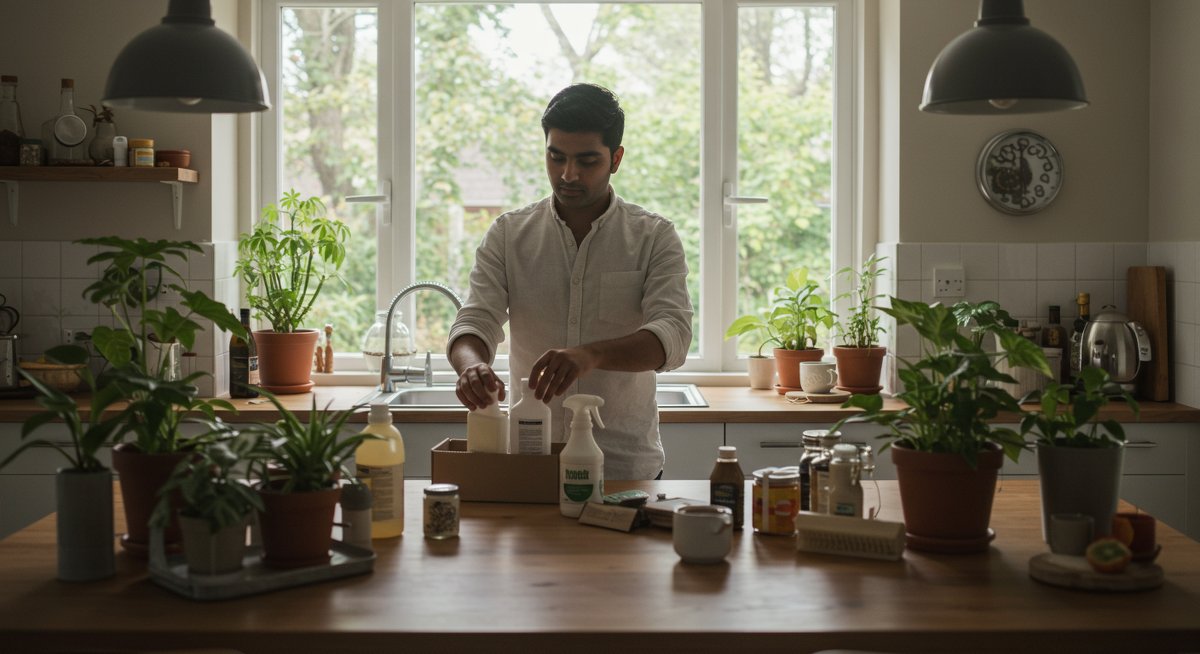Creating a vegan home is more than just a trend; it's a commitment to compassion, sustainability, and a healthier lifestyle. For those of us navigating this journey, it's an opportunity to align our living spaces with our values, making conscious choices that minimise harm to animals and the planet. It's about curating a space that reflects our ethical beliefs and fosters a sense of well-being. This guide will provide you with actionable steps, product recommendations, and insights to transform your home into a haven of ethical living. Let's get started!

Why choose a vegan home?
Choosing a vegan home is a powerful way to extend your ethical choices beyond your plate. It's about making informed decisions that consider the impact of your everyday purchases on animals, the environment, and your own well-being. Think about it: every item in your home has a story, from its production to its disposal. A vegan home ensures that this story aligns with your values. So what does this mean in practice?
Reducing animal cruelty
One of the primary reasons for embracing a vegan home is to eliminate products that involve animal exploitation. Many household items, from cleaning products to furniture, contain animal-derived ingredients or are tested on animals. By opting for vegan alternatives, you actively support cruelty-free practices and contribute to a world where animals are treated with respect.
For example, consider leather furniture. While it might seem stylish, the leather industry is often associated with significant animal welfare concerns. Opting for furniture made from vegan leather alternatives, like microfiber or plant-based materials, eliminates this ethical dilemma.
Minimising environmental impact
A vegan home also prioritises sustainability. Many vegan products are also eco-friendly, reducing your carbon footprint and promoting responsible consumption. This could include choosing cleaning products with biodegradable formulas or opting for furniture made from recycled materials.
For instance, the production of many traditional cleaning products involves harsh chemicals that can pollute waterways and harm ecosystems. By choosing plant-based, biodegradable cleaners, you contribute to a healthier environment.
Promoting health and well-being
A vegan home often fosters a healthier living environment. Vegan products frequently avoid harsh chemicals and toxins found in conventional products, which can improve your indoor air quality and reduce exposure to allergens. It's a win-win for your health and the planet!
For example, traditional air fresheners often contain synthetic fragrances that can trigger allergies or respiratory issues. Opting for natural alternatives, like essential oil diffusers or houseplants, can create a fresher, healthier atmosphere.
Essential swaps: Your vegan home toolkit
Embarking on your vegan home journey can feel overwhelming, but it doesn't have to be. Here are some essential swaps to get you started:
Cleaning products
Switching to cruelty-free and plant-based cleaning products is one of the easiest and most impactful changes you can make. Many conventional cleaners contain harsh chemicals, animal-derived ingredients, and are tested on animals. Vegan cleaning products are formulated with plant-based ingredients, are cruelty-free, and are often biodegradable, making them a healthier and more sustainable choice.
Examples:
- All-Purpose Cleaners: Look for brands like Aunt Fannie's or Puracy. These cleaners are effective, plant-based, and come in eco-friendly packaging. This switch is simple, often requiring just a swap from your existing spray bottles.
- Dish Soap: Consider brands like Mrs. Meyer's Clean Day (make sure to check for vegan certification as not all scents are vegan) or Biokleen. Vegan dish soaps are just as effective at cutting through grease and grime without compromising your values.
- Laundry Detergent: Brands like Method and Attitude offer vegan laundry detergents that are both effective and gentle on the environment. Many come in concentrated formulas, reducing plastic waste.
Expert Tip: When choosing cleaning products, look for certifications like Leaping Bunny or PETA, which indicate that the product is cruelty-free. Also, consider buying in bulk to reduce packaging waste.
Common Mistakes:
A common mistake is assuming that natural means vegan. Always check the ingredients list, as some "natural" products may contain honey, beeswax, or other animal-derived ingredients.
Furniture & decor
Choosing vegan furniture and decor means ensuring that your home is free from animal products like leather, wool, and down. Fortunately, there are numerous stylish and sustainable options available.
Examples:
- Vegan Leather Alternatives: Instead of leather, choose furniture made from materials like microfiber, vinyl, or plant-based leather. These options are durable, stylish, and cruelty-free. You can often find these at stores like IKEA or online retailers that specialize in eco-friendly furniture.
- Sustainable Fabrics: Opt for fabrics like organic cotton, linen, or hemp for upholstery and bedding. These materials are not only vegan but also more sustainable than conventional options.
- Upcycled and Vintage Decor: Shopping for vintage or upcycled decor is a fantastic way to find unique pieces while reducing waste and avoiding new production. You can often find great pieces at local thrift stores or online marketplaces.
Expert Tip: Research brands that prioritize ethical sourcing and sustainable manufacturing processes. Look for certifications like GOTS (Global Organic Textile Standard) for textiles.
Common Mistakes:
One common mistake is overlooking the small details. For example, some pillows and cushions may contain down feathers. Always check the materials list carefully.

Kitchen essentials
Creating a vegan kitchen is more than just about what you eat; it's about the tools and accessories you use. Here are some essential swaps:
Examples:
- Non-Stick Cookware: Many non-stick pans use Teflon, which can sometimes contain animal by-products. Instead, opt for ceramic or stainless steel cookware. These options are durable, safe, and cruelty-free.
- Wooden Utensils: Replace plastic utensils with wooden or bamboo utensils. They are eco-friendly and can make your cooking feel more natural and connected to nature.
- Food Storage Containers: Ditch plastic containers for glass or stainless steel options. They are safer for food storage, and also reduce the environmental impact.
Expert Tip: Always check the labels of your cookware to ensure it's vegan-friendly. Some brands may use animal-derived glazes or coatings.
Common Mistakes:
A common mistake is not paying attention to the small details in the kitchen. Always check the labels of your cookware and accessories to ensure they are vegan-friendly.
Lifestyle hacks for a vegan home
Integrating vegan practices into your daily routine can significantly enhance your overall experience. Here’s how to make it a seamless part of your life.
Examples:
- Eco-Friendly Candles: Many candles contain beeswax or paraffin wax, a petroleum byproduct. Instead, choose candles made from soy wax, coconut wax, or beeswax alternatives and essential oils. Look for brands that use sustainable and cruelty-free practices.
- Vegan Home Fragrance: Explore options such as reed diffusers with plant-based essential oils. These provide a beautiful scent without the use of animal products or harsh chemicals.
- Ethical Stationery: Switch to paper products and stationery that are made sustainably. Consider using recycled paper products for your notebooks, sticky notes, and other office supplies. This is an easy step that supports your values.
Expert Tip: Make a habit of reading labels carefully. Be mindful of materials like wool, silk, and leather, which may be used in blankets, rugs, or other home items.
Common Mistakes:
A common mistake is forgetting to factor in everyday items like candles and air fresheners. It's easy to overlook these small details, but they can make a big difference.
Deep dive: Advanced vegan home strategies
For those looking to take their vegan home to the next level, here are some advanced strategies.
Zero-waste living
Embracing zero-waste practices can significantly reduce your environmental impact and align with your vegan values. This involves minimising waste by reducing, reusing, and recycling.
Examples:
- Composting: Start a compost bin for food scraps and yard waste. Composting reduces landfill waste and creates nutrient-rich soil for your garden.
- Reusable Products: Replace disposable items with reusable alternatives, such as cloth towels, reusable shopping bags, and silicone food storage bags. This reduces waste and saves money in the long run.
- Bulk Buying: Buy food and household products in bulk to reduce packaging waste. Many stores offer bulk sections where you can fill your own containers.
Expert Tip: Start small and gradually incorporate more zero-waste practices into your routine. Don’t try to do everything at once.
Common Mistakes:
A common mistake is feeling overwhelmed by the idea of zero waste. Start with one or two changes, and gradually incorporate more practices as you become more comfortable.
Ethical shopping
Support ethical and sustainable brands that align with your values. Research companies that prioritize fair labour practices, sustainable materials, and cruelty-free manufacturing processes.
Examples:
- Research Brands: Before making a purchase, research the brand's values and practices. Look for brands that are transparent about their supply chains and committed to ethical sourcing.
- Support Local: Shop at local businesses and markets to support your community and reduce your carbon footprint. This is also a great way to find unique, handcrafted vegan products.
- Secondhand Shopping: Embrace secondhand shopping for furniture, decor, and clothing. This reduces waste and gives unique pieces a new life.
Expert Tip: Use online resources and apps to identify ethical and vegan-friendly brands. Some websites and apps provide lists of companies that meet specific criteria.
Common Mistakes:
One common mistake is assuming that a brand is ethical just because it claims to be. Always do your research and check for certifications.
Sustainable decor
Creating a sustainable home involves more than just choosing vegan products. It also means making environmentally conscious choices in your decor.
Examples:
- Choose Natural Materials: Opt for natural materials like wood, bamboo, and stone. These materials are renewable and biodegradable.
- Upcycle and Repurpose: Get creative with upcycling and repurposing old items. Turn old furniture into new pieces or use reclaimed materials in your decor.
- Support Sustainable Brands: Choose brands that use sustainable materials and ethical production processes. Look for certifications like FSC (Forest Stewardship Council) for wood products.
Expert Tip: Consider the environmental impact of the materials used in your decor. Choose items made from renewable, recycled, or reclaimed materials whenever possible.
Common Mistakes:
A common mistake is focusing only on the visual appeal of decor and overlooking the environmental impact.
The path forward: Your ongoing journey
Embracing a vegan home is a journey, not a destination. It's about continually learning, making informed choices, and adapting your practices as you discover new information and options. It's a process of growth and refinement.
Staying informed
To stay current on the best vegan home solutions, remain informed. Read blogs, follow social media accounts, and subscribe to newsletters from vegan lifestyle experts. This will help you discover new products, learn about ethical brands, and get inspiration for your own home.
You can also research ingredient labels and understand the different terms for animal-derived and cruelty-tested ingredients, and identify certifications like the Leaping Bunny. Stay updated to the newest information and the latest trends.
Community engagement
Join online communities, forums, and local groups of vegans and eco-conscious individuals. Share your experiences, ask questions, and learn from others. By connecting with like-minded people, you'll find support, inspiration, and new ideas for your vegan home.
One important part of this is to attend vegan events. This is an excellent way to discover new products, meet local vegan entrepreneurs, and be part of a vibrant, ethical community.
Continuous improvement
Make a habit of reviewing your home practices regularly. Look for areas where you can make further improvements, such as switching to more sustainable products or reducing waste. There’s always something new to learn!
Set small, achievable goals for yourself. For example, commit to switching to a new vegan cleaning product each month or reducing your plastic waste by a certain percentage. Small changes lead to big results.
If you're on this journey too, I'd love to hear how it goes for you.